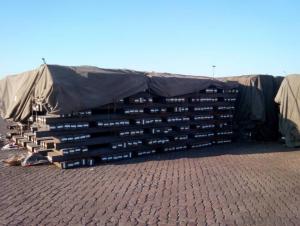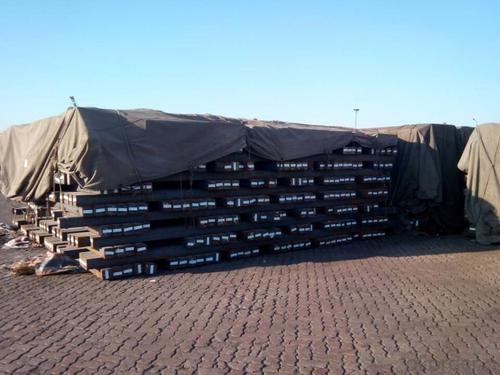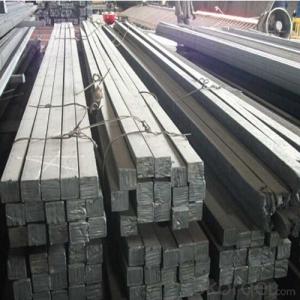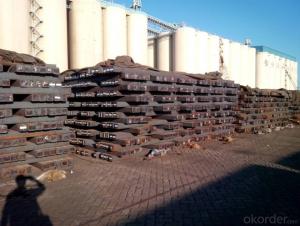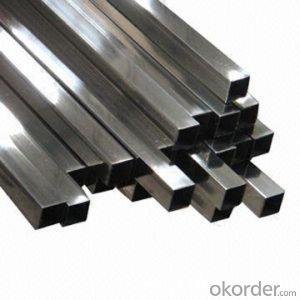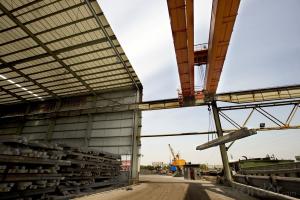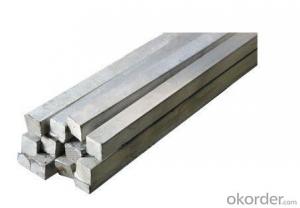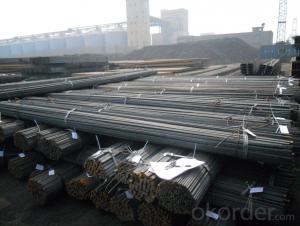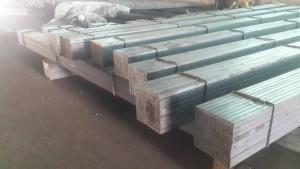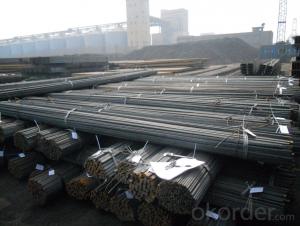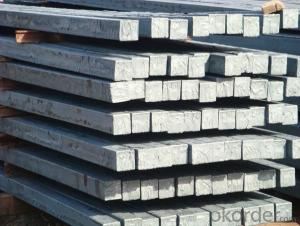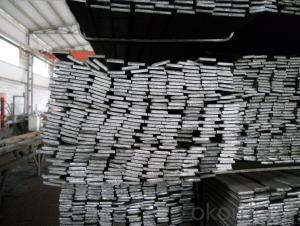Hot Rolled Square Carbon Steel Bar Material Q195
- Loading Port:
- Qingdao
- Payment Terms:
- TT or LC
- Min Order Qty:
- 25 m.t.
- Supply Capability:
- 3000 m.t./month
OKorder Service Pledge
OKorder Financial Service
You Might Also Like
Product Description:
OKorder is offering Hot Rolled Square Steel Barat great prices with worldwide shipping. Our supplier is a world-class manufacturer of steel, with our products utilized the world over. OKorder annually supplies products to European, North American and Asian markets. We provide quotations within 24 hours of receiving an inquiry and guarantee competitive prices.
Product Applications:
The Square Steel is normally used as structure steel.
Row material for other structure steel like steel angles, channels, I-beams, H-beams, etc…
Product Advantages:
OKorder's Hot Rolled Square Steel Bar Material Q195 are durable, strong, and resist corrosion.
Main Product Features:
· Premium quality
· Prompt delivery & seaworthy packing (30 days after receiving deposit)
· Corrosion resistance
· Can be recycled and reused
· Mill test certification
· Professional Service
· Competitive pricing
Product Specifications:
Length of a side(mm) | Theoretical weight(kg/m) | Length of a side(mm) | Theoretical weight(kg/m) |
6 | 0.283 | 32 | 8.04 |
7 | 0.385 | 33 | 8.55 |
8 | 0.502 | 34 | 9.07 |
9 | 0.636 | 35 | 9.62 |
10 | 0.785 | 36 | 10.17 |
11 | 0.950 | 38 | 11.24 |
12 | 1.13 | 40 | 12.56 |
13 | 1.33 | 42 | 13.85 |
14 | 1.54 | 45 | 15.90 |
15 | 1.77 | 48 | 18.09 |
16 | 2.01 | 50 | 19.63 |
17 | 2.27 | 53 | 22.05 |
18 | 2.54 | 55 | 23.6 |
19 | 2.82 | 56 | 24.61 |
20 | 3.14 | 58 | 26.4 |
21 | 3.46 | 60 | 28.26 |
22 | 3.80 | 63 | 31.16 |
23 | 4.15 | 65 | 33.17 |
24 | 4.52 | 68 | 36.3 |
25 | 4.91 | 70 | 38.49 |
26 | 5.30 | 75 | 44.16 |
27 | 5.72 | 80 | 50.24 |
28 | 6.15 | 85 | 56.72 |
29 | 6.60 | 90 | 63.59 |
30 | 7.06 | 95 | 70.85 |
31 | 7.54 | 100 | 78.50 |
Notes:
1, The theoretical weights in the list, base on the density of 7.85 g/cm3.
2, The numbers with mean that they are not regulars or we don’t offer them.
-List 2. The allowed tolerance of Square Steel:
Length of a side(mm) | Allowed Tolerance | ||
Group1 | Group2 | Group3 | |
5.5~7 | ±0.20 | ±0.30 | ±0.40 |
7~20 | ±0.25 | ±0.35 | ±0.40 |
20~30 | ±0.30 | ±0.40 | ±0.50 |
30~50 | ±0.40 | ±0.50 | ±0.60 |
60~80 | ±0.60 | ±0.70 | ±0.80 |
80~110 | ±0.90 | ±1.0 | ±1.1 |
110~150 | ±1.2 | ±1.3 | ±1.1 |
150~190 | ―― | ―― | ±2.0 |
190~250 | ―― | ―― | ±2.5 |
Chemical Composition:
Standard | Grade | Element (%) | ||||
GB | Q195 | C | Mn | S | P | Si |
≤0.12 | ≤0.50 | ≤0.04 | ≤0.035 | ≤0.3 | ||
-Method of deoxidation: F, b, Z
Usage/Applications of Square Steel:
-The Square Steel is normally used as structure steel.
-Row material for other structure steel like steel angles, channels, I-beams, H-beams, etc…
Packaging & Delivery of Square Steel:
-Packing Detail: The products can be packed in bundles by steel wires.
-Delivery Detail: 30~45 working days after receive buyer’s T.T. or L/C.
Transportation & Marking:
-Transportation:
1, The products can be delivered by bulk vessel or by container.
2, The maximum quantity of loading of container is 25 tons.
3, The products usually are transported to the nearest port from the production place.
-Marks:
1, Color mark: there will be color marking on both ends of the bundles for the cargo delivered by bulk vessel. That makes is easily to distinguish at the destination port.
2, Tag mark: the tag marks will be tied up to each bundle. The information is usually including supplier’s logo and name, product name, made in China, products’ specifications and other information requested by customers.
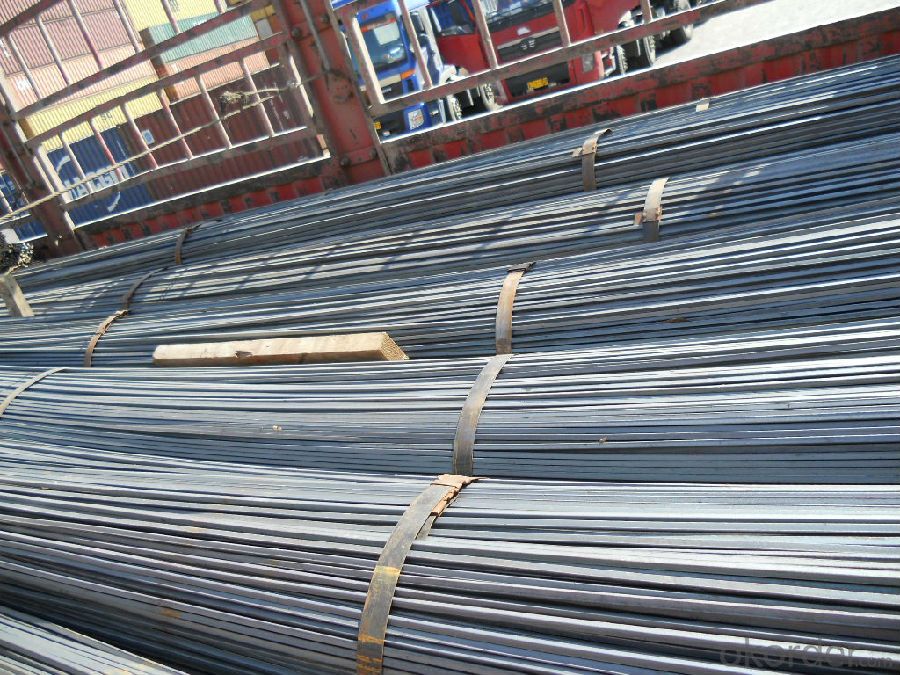
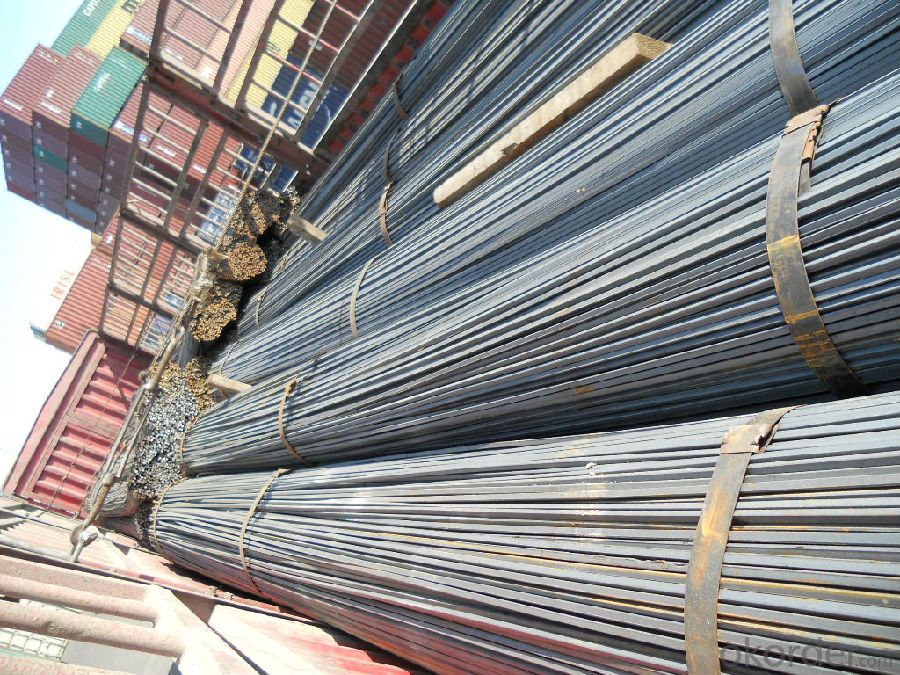
FAQ:
Q1: Why buy Materials & Equipment from OKorder.com?
A1: All products offered byOKorder.com are carefully selected from China's most reliable manufacturing enterprises. Through its ISO certifications, OKorder.com adheres to the highest standards and a commitment to supply chain safety and customer satisfaction.
Q2: How do we guarantee the quality of our products?
A2: We have established an advanced quality management system which conducts strict quality tests at every step, from raw materials to the final product. At the same time, we provide extensive follow-up service assurances as required.
Q3: How soon can we receive the product after purchase?
A3: Within three days of placing an order, we will begin production. The specific shipping date is dependent upon international and government factors, but is typically 7 to 10 workdays.
Q4: What makes stainless steel stainless?
A4: Stainless steel must contain at least 10.5 % chromium. It is this element that reacts with the oxygen in the air to form a complex chrome-oxide surface layer that is invisible but strong enough to prevent further oxygen from "staining" (rusting) the surface. Higher levels of chromium and the addition of other alloying elements such as nickel and molybdenum enhance this surface layer and improve the corrosion resistance of the stainless material.
- Q: How do you use a steel square to find the square footage of a patio?
- To use a steel square to find the square footage of a patio, you need to follow a few steps. First, ensure that the steel square is clean and free from any debris. Next, measure one side of the patio using the long edge of the steel square. Place the steel square against the edge of the patio, aligning the long edge with the side you want to measure. Hold the square firmly in place and make sure it is flush against the edge. Once the square is properly aligned, take note of the measurement indicated on the steel square's short edge. This measurement represents the length of one side of the patio. Repeat the process for the remaining sides of the patio, measuring each side with the steel square. Take note of the measurements for each side. To find the square footage, multiply the length of one side by the length of the adjacent side. For example, if one side measures 10 feet and the adjacent side measures 12 feet, multiply 10 by 12 to get 120 square feet. If the patio has irregular shapes or curves, you can still use the steel square to measure the square footage. Break the patio into smaller sections with straight edges and measure each section individually. Then, add up all the individual measurements to get the total square footage of the patio. Remember to account for any openings or obstacles in your calculations, as you may need to subtract their square footage from the total area. Using a steel square to find the square footage of a patio ensures accuracy and precision in your measurements, helping you determine the right amount of materials needed for your project.
- Q: Can a steel square be used for checking the alignment of tiles?
- Yes, a steel square can be used for checking the alignment of tiles. A steel square is a versatile tool that is commonly used in carpentry and tile work. Its straight edges and right angles make it ideal for ensuring that tiles are properly aligned and level. By placing the steel square against the edges of the tiles, one can easily determine if they are aligned correctly and make adjustments if needed. Additionally, the steel square can also be used to check the corners of the tiles, ensuring that they form perfect right angles. Overall, a steel square is a reliable tool for checking tile alignment and can help achieve a professional and aesthetically pleasing result.
- Q: How do you use a steel square for creating parallel lines?
- To create parallel lines using a steel square, follow these steps: 1. Place the steel square onto the surface or material where the parallel lines are desired. 2. Align one edge of the steel square with the reference point or starting edge for the parallel lines. 3. Securely hold the steel square in place to prevent any movement. 4. Use a pencil or marking tool to make a mark or draw a line along the edge of the steel square. 5. Without shifting the steel square, glide it along the surface or material while maintaining alignment with the reference point. 6. Make another mark or draw another line along the edge of the steel square at the desired distance from the previous line. 7. Repeat this process for the desired number of parallel lines, consistently aligning the same edge of the steel square with the reference point and marking along the opposite edge. By consistently aligning the steel square with the reference point and marking along its edges, one can create multiple parallel lines with precision and accuracy.
- Q: How do you use a steel square to check for plumbness in a wall?
- To check if a wall is plumb, you can follow these steps using a steel square: 1. Begin by choosing a steel square, which is a measuring tool with a 90-degree angle. It consists of a long blade and a shorter tongue that is perpendicular to the blade. 2. Stand beside the wall that you want to check for plumbness. Hold the steel square so that the blade is vertical and the tongue is horizontal, with the tongue touching the wall. 3. Position the blade of the steel square against the wall, ensuring it is flush with the surface. 4. Examine the space between the tongue and the wall. If the wall is plumb, there should be no gap. A gap suggests that the wall is not perfectly vertical. 5. To determine the extent of plumbness, you can use a level on the tongue of the steel square. Place the level on the top of the tongue and adjust it until it indicates a completely vertical position. This will help you identify the exact angle of deviation from plumbness. 6. Repeat this process at different points along the wall to ensure consistency. Checking at multiple locations is crucial to confirm that the entire wall is plumb. By utilizing a steel square, you can conveniently and accurately assess the plumbness of a wall. This is especially valuable when undertaking construction or carpentry projects that demand precise alignment and verticality.
- Q: What are the different ways to hold a steel square when making angle measurements?
- There are several different ways to hold a steel square when making angle measurements. 1. The first and most common method is to hold the steel square firmly against the material being measured, ensuring that both edges of the square are in contact with the material. This allows for accurate angle measurements by aligning the square's edges with the desired angle. 2. Another way is to use a clamp or a vise to secure the steel square in place. This method is particularly useful when working with larger materials or when needing to make multiple angle measurements without the risk of the square moving. 3. One can also use a magnetic base or a magnetic holder to attach the steel square to the material. This provides stability and allows for hands-free operation, especially when working with vertical or overhead surfaces. 4. For more precise angle measurements, a protractor or angle finder can be used in conjunction with the steel square. By aligning the square's edge with the desired angle and then measuring the angle using the protractor or angle finder, accurate measurements can be obtained. 5. In some cases, a steel square can also be clamped onto a sliding bevel or adjustable bevel, which allows for the setting of custom angles. This method is particularly useful when working with irregular or non-standard angles. Ultimately, the choice of how to hold a steel square when making angle measurements depends on the specific application, the size of the material being measured, and the desired level of accuracy.
- Q: Can a steel square be used for deck building?
- Certainly, a steel square is an excellent tool for constructing decks. These squares, also referred to as framing squares or carpenter squares, possess remarkable versatility and are widely utilized in construction projects, such as deck building. Typically composed of steel, they boast a 90-degree angle, facilitating precise measurements and the marking and cutting of angles. The utility of steel squares is particularly evident in the layout and measurement of deck framing, guaranteeing square corners and proper alignment of joists, resulting in a structurally robust and level deck. Moreover, steel squares exhibit exceptional durability and can endure the challenges of outdoor construction, rendering them a trustworthy asset for deck building.
- Q: How do you use a steel square to draw perpendicular lines?
- To use a steel square to draw perpendicular lines, place the long edge of the square against the straight edge of your paper or drawing surface. Make sure it is aligned properly and firmly. Then, use a pencil or pen to trace along the other edge of the square, creating a straight perpendicular line.
- Q: How do you use a steel square to determine the slope of a wheelchair ramp with different heights?
- To use a steel square to determine the slope of a wheelchair ramp with different heights, follow these steps: 1. Begin by placing the steel square on the ramp's surface, ensuring that one edge of the square is parallel to the ground and the other edge is perpendicular to it. 2. Position the square at the bottom of the ramp, aligning the perpendicular edge with the ground. Make sure it is firmly against the surface. 3. Measure the vertical rise or height of the ramp from the ground level to the highest point at the top of the ramp. 4. Slide the square up the ramp while keeping the perpendicular edge aligned with the ground. Stop once the horizontal (parallel to the ground) edge is touching the highest point of the ramp. 5. Observe where the vertical edge of the square intersects with the ramp's surface. This point indicates the horizontal distance traveled along the ramp for the given vertical rise. 6. Measure the horizontal distance from the starting point (where the square first touched the ground) to the point where the vertical edge intersects with the ramp's surface. 7. Now, to determine the slope of the ramp, divide the vertical rise by the horizontal distance traveled along the ramp. This will give you the slope ratio or the rise-to-run ratio. For example, if the vertical rise is 24 inches and the horizontal distance is 192 inches, the slope ratio would be 24/192, which simplifies to 1/8. This means that for every 8 units traveled horizontally along the ramp, there is a rise of 1 unit vertically. Using a steel square in this manner allows you to accurately determine the slope of a wheelchair ramp with different heights, ensuring it meets the necessary requirements for accessibility and safety.
- Q: How do you use a steel square to find the square footage of a pool?
- To use a steel square to find the square footage of a pool, you would need to measure the length and width of the pool using the steel square. Once you have these measurements, you can multiply them together to calculate the square footage of the pool.
- Q: Are there any alternative tools to a steel square?
- Yes, there are several alternative tools to a steel square. Some commonly used alternatives include: 1. Speed Square: Also known as a rafter square, this tool has a triangular shape and is usually made of aluminum. It is specifically designed for measuring and marking angles, making it useful for carpentry and other construction projects. 2. Combination Square: This tool consists of a ruler and a pivoting head that can be set at any angle. It is widely used in woodworking and metalworking for measuring and marking straight lines, right angles, and various angles. 3. Framing Square: This square is larger than a steel square and is typically made of aluminum or steel. It is commonly used in construction for measuring and marking right angles, laying out stairs, and checking roof pitches. 4. Bevel Gauge: This tool is used for measuring and transferring angles. It consists of an adjustable blade and a handle, allowing it to be set at various angles. It is commonly used in woodworking and metalworking for creating precise angles. 5. Angle Finder: Also known as a protractor or angle gauge, this tool is used for measuring and transferring angles accurately. It typically consists of a round disc with a scale and a pivoting arm or blade. These alternative tools provide different functionalities and features, catering to specific needs in various industries. While a steel square is versatile and widely used, these alternatives offer additional options for specific tasks and angles.
Send your message to us
Hot Rolled Square Carbon Steel Bar Material Q195
- Loading Port:
- Qingdao
- Payment Terms:
- TT or LC
- Min Order Qty:
- 25 m.t.
- Supply Capability:
- 3000 m.t./month
OKorder Service Pledge
OKorder Financial Service
Similar products
Hot products
Hot Searches
Related keywords
